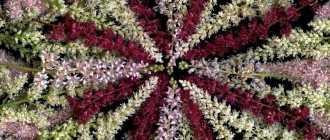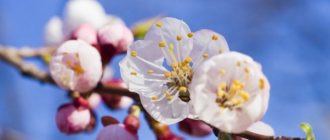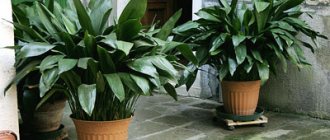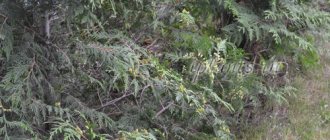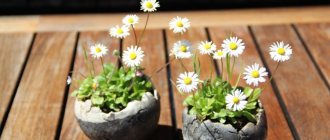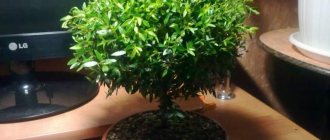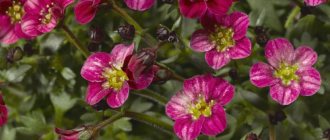Home » Landscape design » Lianas, Bushes and Trees
Vladimir 03/16/2020
4820 Views
In temperate climate zones, bamboo is rarely grown at home, especially in open ground. This is due to the fact that it is difficult to tolerate frost. The plant has good adaptation; after overwintering once, it can withstand frost more easily. For those who want to grow a bamboo alley, the article will help you choose a variety and learn the features and recommendations for growing.
General information
Bamboo belongs to the grass family
This is a perennial, evergreen plant. Botany describes it as a leafy plant. It is distributed over a large area of our planet. It can be found in both tropical and temperate latitudes.
The variety of varieties has a common feature - a hollow stem - a straw. Bamboo vines have a full stem. In height there are low types of 25 cm and high ones up to 40 m, vines grow up to 120 m.
The plant is divided into 2 types:
- Bushy bamboo
- running bamboo
Running bamboo has a creeping root system. When planting varieties of this type, you need to create a barrier , otherwise the entire area will be overgrown with bamboo. Bushy is distinguished by short, slow-growing roots.
In addition, there is also a division into tribes:
- Olyraceae - grow like all cereals, their height does not exceed 1 meter
- The bamboo tribe is distinguished by its high growth up to 40 meters. Their trunk becomes woody over time
What does the number of stems mean?
The number of stems is an important factor for anyone looking to purchase live bamboo.
- The two stems symbolize the happiness of the family.
- Three stems attract happiness.
- Four stems are best avoided as 4 is the number of death.
- Five stems carry wealth.
- Seven stems will bring health.
- Eight stems - active growth in all areas of life.
- Nine stems - good luck and success in everything.
- Twenty-one stems will have a positive effect on everything that happens in life.
Bloom
Bamboo rarely blooms. Some varieties take 100 years, some low-growing varieties take 20. The flowering process requires a lot of energy. The plant devotes all its vitality to it and, when finished, dies.
The reasons for rare flowering have been little studied
If one bamboo blooms, then all its neighbors bloom. This can be prevented by trimming the buds. This leads to the death of the plant in this area. A similar case was recorded in Europe at the end of the twentieth century.
Scientists believe that this is due to the fact that no one eats bamboo seeds. The process ensures the formation of seeds for plant propagation.
Growing in open ground
Before planting bamboo, you need to evaluate the conditions for the plant's growth. This is done according to five main criteria:
- Variety
- Lighting
- windiness
- Temperature
- The soil
When choosing a variety, you need to clearly understand for what purposes it will be planted. Here its height and the shape of the leaves will be important. Some species look good alone, others need to be planted in groups.
It is important to analyze the temperature of the climate zone. There are varieties that can withstand frosts down to -28 degrees, and some will die at -15. Otherwise, the plant will die at the first frost, all efforts will be in vain.
Bamboo is not fussy. Despite this fact, it receives nutrition through the root system from the soil.
Therefore, the more nutritious it is, the better it will grow and develop. If the soil is poor, it needs to be enriched with fertilizer. Dense soil will slow down growth, but such soil freezes less easily. In the cold season, this feature will save the roots from freezing.
Many varieties of bamboo love sunlight. There are also shade-tolerant varieties. It grows faster and develops better in the sun. In winter, it depletes the plant. In the dry climate of the planting region, it is better to choose a place in partial shade.
Bamboo does not tolerate wind. Therefore, before planting a plant, it is important to come up with a protective barrier against it.
Sharp turn
Bamboo is not born curly, it becomes so after “curling”
Often bamboo is purchased for only one purpose - to obtain a plant with a bizarre stem shape. Unfortunately, bamboo itself will not wrap itself in a perky spiral, but by organizing proper care and being patient, you have every chance of success:
| Photo | Description |
| Method 1. The plant is planted vertically. At the moment of bud formation, the bamboo is covered with a cardboard box, leaving a small hole for sunlight to penetrate. The sprouts will strive for sunlight and in order for them to “curl”, you will have to turn the bamboo in different directions relative to the “window” in the opaque covering structure. Thus, one spiral will be formed in a year. | |
| Method 2. The second option involves temporary cultivation in water. The stem is placed horizontally in a transparent container with water and wound onto a rod of suitable diameter. Subsequently, the bamboo is transplanted into the ground, the “curlers” are removed, and the curls are temporarily fixed with wire. |
Bamboo allows you to “twist ropes” and, for your sweet soul, will curl up not only into a spring, but also into an intricate lattice
Instructions for planting in open ground
Bamboo should be planted in the ground as seedlings
So, it will take root faster. Planting should be done in spring or summer. The sooner this is done, the stronger it will become by the winter.
For successful wintering, the roots must be covered for the first year . To prevent young shoots from dying, you need to install protection from the wind. Cold gusts of which will destroy the plant.
Landing
Planting bamboo
Planting is carried out in several stages:
- The lump of earth with roots should be well saturated with water. If this is not done, it will not flow well even with abundant watering. To do this, the pot with the seedling is lowered into a container filled with water. Must be kept in the shade. This procedure will protect the roots from damage when it comes time to pull.
- A hole is dug larger than a coma with roots.
- The soil is fertilized. Humus and humus are added to the pit.
- When choosing running bamboo, a root barrier is installed.
- Place the seedling in the middle of the hole, fill the void with soil and compact it.
- Water the young plant generously.
You cannot fertilize bamboo with fresh manure and chicken droppings. They can burn the roots.
Bamboo running barrier
The roots of running bamboo varieties grow quickly. They spread at a depth of 20 cm, but can come to the surface. A limiter is placed on the site before planting. It is dug to a depth of one and a half meters, with the upper edge protruding 10 cm from the ground.
Barrier device
To limit the spread of the plant you can use:
- Slate
- Metal
- Barrier film
- Root barrier
To prevent the roots from falling through the limiter, you need to dig in at an angle. The top edge of the plant should be located at a greater distance from the trunk. The edges overlap each other.
If the root has bypassed the barrier, you can cut off the unnecessary part. Be sure to pull the piece out of the ground. Otherwise, it will spread further, filling the entire space with young bamboo shoots.
Watering
During the first months after planting, you need to ensure that the soil does not dry out. Water generously. This will speed up the rooting process. But you cannot allow water to stagnate, otherwise the roots will begin to rot.
Bamboo does not tolerate drought
If there is a lack of moisture, the leaves will begin to curl into a tube. The plant quickly dies from drying out. After the bamboo begins to dry, watering is reduced to 3 times a week.
If there is a lack of moisture, as with all cereals, the roots will begin to move deeper. The plant will extract moisture from the depths of the earth. The frequency of watering must be adjusted depending on natural precipitation. In rainy years, watering is reduced.
Mulching
In autumn it is recommended to mulch. Mulch consists of pine bark, wood chips, hay, straw or peat.
Mulching the soil
The layer should be no more than 5 cm . A thick layer may attract rodents, which will damage the bamboo. This layer will ensure stable soil temperature and moisture.
Trimming
The plant is pruned once a year. It should be done in the spring. Remove dry, frozen and unsightly shoots.
Bamboo trimming
If the thickets are dense, thinning is carried out. This procedure will allow the sun's rays to penetrate deeper. Bamboo straws have knots. If you cut above the bud, a new shoot will grow.
Top dressing
Fertilizing is carried out 2 times a year: in spring and autumn. To do this, nitrogen, phosphate and potassium fertilizers are mixed. In spring the ratio should be 4:3:2, in autumn 2:4:4.
When choosing organic fertilizers, they should be applied once a month in spring and summer.
In this case, in autumn and winter, bamboo takes a break from feeding.
Wintering
The upper part of the plant freezes in the first year of growth at -17 degrees, and dies at -20. If weather forecasters predict a cold winter without snow, then young shoots need to be bent and covered. The best shelter is spruce branches.
With each winter the plant becomes stronger and more resistant to frost.
When the trunk and shoots die, the roots are preserved. They are warmer in the ground. There is a chance that they will produce new growth in the spring.
Reproduction
There are 2 ways to grow bamboo:
- From seeds
- Vegetatively
Let's look at them in detail.
Seed propagation
Bamboo seeds
The difficulty of the seed method lies in the rare flowering. The positive side is that bamboo grown this way will be less sick. Its life cycle will be approximately equal to the cycle of the parent plant.
Seed preparation consists of several stages:
- They are dried in the sun for 2 hours
- Soak the planting material in water for 10 - 12 hours. Water is drained no earlier than 20 minutes before sowing
While the seeds are soaking, you need to prepare the substrate:
- 8 parts garden soil, top layer
- 1 part wood shavings
- 1 part wood ash
The mixture must be sifted and the container filled for planting. It should be loose. The seeds are deepened by 5 mm and covered with soil on top.
Seedlings are sprayed 2 times a day. The soil must be moist. The first shoots will appear in 20 - 25 days.
They are planted in separate pots after 3 months. During this period, seedlings will begin to produce new shoots. The plant is fragile and must be handled carefully.
The watering mode changes once. It is better to do it in the evening. It is recommended to keep the young plant indoors for the first winter. They are planted in the ground when the trunk grows 50 cm.
Vegetative propagation
The plant can be divided using this method at the age of three. You need to dig up the roots and separate the individual shoots. They must have up to three processes or nodes. And they must also have roots.
Bamboo cuttings
They are planted in a container. The shoots need to be watered once a day and kept in the shade. Transplantation into open ground is carried out in the spring. The plant is kept indoors for the first winter.
Growing indoors
When choosing a location, it is important to consider that bamboo is light-loving. The plant needs to provide a lot of diffused light. If you keep the pot near the window, you need to turn it periodically so that the plant receives the same amount of light from all sides and develops evenly.
You also need to provide air humidification. You can place an aquarium or a container filled with water next to the bamboo. Shoots need to be sprayed 2 times a week.
Indoor bamboo
Watering should be abundant and moderate at the same time. From excess moisture, the roots will rot and the plant will die. In winter, bamboo enters a dormant period and watering is reduced.
If the plant is overwatered and signs of rotting become noticeable. You need to take out the roots, wash them and remove the areas affected by rot.
Indoor bamboo needs to be fertilized regularly from March to September. He prefers nitrogen fertilizing. Everything should be in moderation. If the plant is overfed, it will become weak.
Indoor bamboo will be an excellent decorative element
As the plant grows, it is replanted. The walls of the pot should be dense. The roots can damage it, especially if it is running bamboo. It is better to carry out the procedure in the spring.
In summer it is better to take the pot out onto the balcony or terrace. In the fresh air it will develop better and grow faster.
Choosing a “place of residence”
Since Dracaena Sander is a plant of a hot climate, it needs to choose an appropriate place, warm, with a sufficient amount of indirect sunlight. As an ornamental plant, bamboo can be grown in small flowerpots in single specimens or as a whole family, leaving the stems straight or twisting them into spirals.
Sometimes indoor bamboo is combined with other exotic flowers, such as orchids. In a room where the ceiling height and bright lighting allow, you can create your own miniature forest by planting plants in large floor tubs.
The main criteria for the successful growth of dracaena are:
- proper lighting, temperature conditions, fresh air flow;
- air and soil humidity;
- feeding with fertilizers and regular replanting.
Diseases and pests
Bamboo has good health. It may be affected by a fungus. It appears as rust and spots on the foliage. You can fight it with fungicides.
Sick plant
Young leaves can be attacked by aphids and mealybugs. Remove with a sponge and soap solution. If there are a lot of pests, then chemicals will help.
The leaves are turning yellow
Autumn yellowing of foliage is a natural process
Bamboo sheds up to 30% of its leaves every year. By getting rid of them, the plant saves energy for the winter.
When yellow leaves appear in spring and summer, this indicates a problem:
- Flooding
- Chlorosis
If the soil is clayey, then you definitely need to think about drainage . A layer of sand or stones is placed under the roots. The yellowing process begins due to rotting of the root system.
If bamboo lacks nitrogen, iron or magnesium, chlorosis develops. Another reason may be salty soil. When these deficiencies are corrected, new green leaves will grow.
Answers on questions
Is it possible to keep bamboo in an apartment?
Indoor bamboo is specially bred for growing at home. According to Feng Shui philosophy, bamboo attracts good luck and happiness to the house, and grants longevity to the owner. That's why it is called lucky bamboo.
Why does bamboo turn yellow?
The evergreen plant may turn yellow. This may happen due to:
- lack of light;
- exposure to direct sunlight;
- lack of moisture;
- lack of nutrients;
- poor drainage system;
- drafts;
- watering with unfiltered water.
How fast does indoor bamboo grow and what to do if it grows very slowly
The growth rate is incredible; on average, bamboo reaches medium size in 5 years. If the dracaena suddenly stops growing, this indicates watering with hard water and lack of light.
Leaf blades become limp and curled
This is due to hypothermia.
Why do black spots appear on bamboo leaves?
Bamboo is affected by fungus; ventilation must be provided.
Is it possible to prune indoor bamboo?
It is possible and necessary to trim homemade bamboo; this is often done for decorative purposes.
How to root bamboo at home
For rooting, pinch off the top and place in a glass of water until roots appear. When the first shoots appear, the bamboo is planted in a pot with soil.
Using bamboo
Bamboo plays not only a decorative role
The plant is used quite widely:
- Young shoots are eaten as a vegetable. How crops are grown in Italy.
- The trunks are used as building materials.
- Bamboo is split and its fiber is used to create wicker items.
- The seeds are similar to oats and are also eaten.
- Used to make canes and umbrella handles.
- They make hats.
- Mats and sushi sticks are made from bamboo.
- The Thais used trunks - straws for water supply.
- Furniture is made from bamboo.

